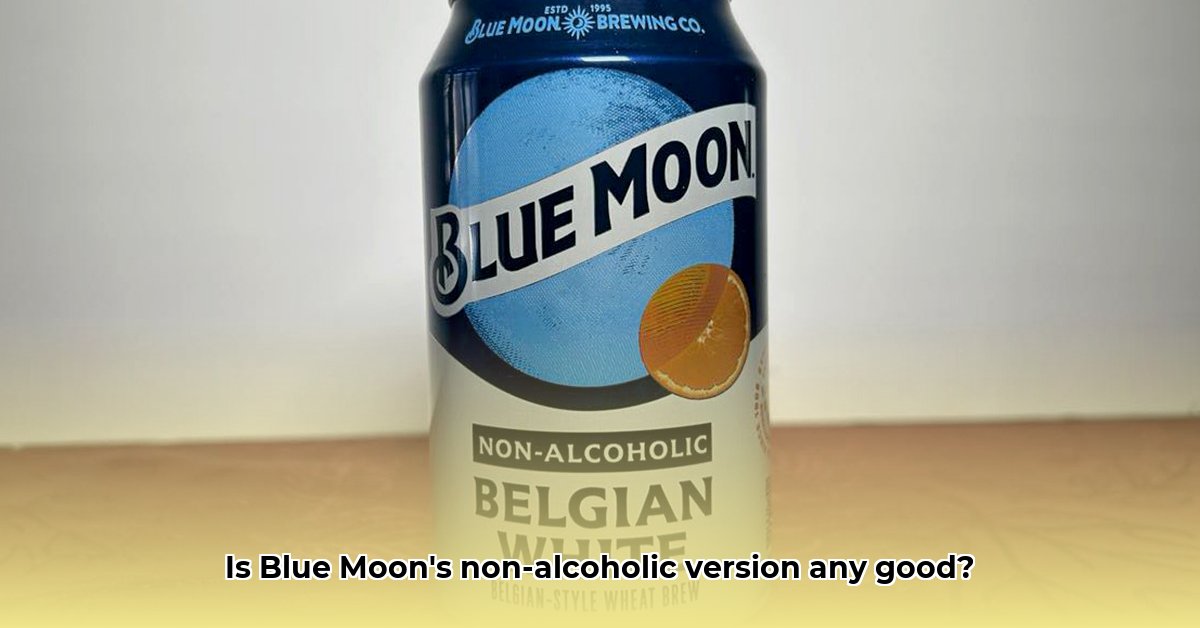
Blue Moon, the iconic Belgian-style wheat ale, has ventured into the burgeoning non-alcoholic beverage market. This review delves into a taste test, comparing the alcohol-free version to its alcoholic counterpart, analyzing its market positioning, and ultimately assessing its value proposition. For more information on Blue Moon's non-alcoholic offerings, check out this helpful resource.
Non-alcoholic Blue Moon Taste Test: A Sensory Exploration
This wasn't just a casual sip; it was a comprehensive sensory analysis. My goal was clear: to determine how closely the non-alcoholic Blue Moon mirrors the original and whether the premium price is justified.
First Impressions: Aroma and Appearance
The initial aroma was strikingly reminiscent of the classic Blue Moon. That signature citrusy, subtly sweet scent was immediately recognizable. The hazy, pale orange hue perfectly replicated the original, creating a visually appealing first impression. This visual similarity immediately sets the stage for a positive experience.
Palate Analysis: Taste and Mouthfeel
The first sip was surprisingly pleasant. The characteristic orange peel and coriander flavors were present, though slightly less pronounced than in the alcoholic version. The mouthfeel was notably different, lighter, and more effervescent – a welcome change for some palates. A subtle sweetness lingered in the aftertaste, a deviation from the original, but not unpleasant. It was a surprising, yet pleasant change to the usual mouthfeel of a Blue Moon. It added a new dimension to the drinking experience while maintaining the essence of the brand.
Rating: 4 out of 5 stars. A very close approximation, but with subtle nuances.
Head-to-Head Comparison: Alcoholic vs. Non-alcoholic
The key question is: how does the non-alcoholic version stack up against its alcoholic predecessor? While the flavor profiles are remarkably similar, the body noticeably differs. The alcoholic Blue Moon boasts a fuller, richer mouthfeel; the non-alcoholic version is lighter, more akin to a refreshing, effervescent beverage. This difference isn't drastic, but noticeable, creating distinct drinking experiences; the original offering a richer, fuller experience, while the non-alcoholic one focuses on refreshment.
Market Analysis: Pricing and Positioning
Blue Moon's entry into the non-alcoholic market is a strategic move, capitalizing on its popularity and the growing demand for alcohol-free alternatives. However, the pricing strategy is a significant factor. It's priced similarly to the alcoholic version, potentially positioning it as a premium offering for those who value familiarity and consistent quality.
This bold pricing strategy could deter budget-conscious consumers. The long-term success of this product hinges on whether consumers value the familiar taste and quality over cost. Will the brand loyalty of Blue Moon out weigh the additional cost for a non-alcoholic counterpart.
Pros and Cons: A Balanced Perspective
To provide a comprehensive review, it's essential to highlight both the strengths and weaknesses:
| Pros | Cons |
|---|---|
| Exceptional taste similarity to the original | Higher price point than many competitors |
| Wide availability | Slightly lighter body and less complex flavor profile |
| Refreshing and enjoyable | Aftertaste sweetness may be polarizing |
The Verdict: Is it Worth the Price?
The non-alcoholic Blue Moon delivers a remarkably close approximation of the original's taste. For Blue Moon loyalists seeking an alcoholic alternative, it's a compelling choice, despite the higher price. However, for those on a budget or seeking alternatives, more affordable options exist. The non-alcoholic Blue Moon occupies a niche market: a premium alcohol-free option for those who can justify the additional cost or are looking for a special-occasion drink, rather than an everyday beverage.
How does this non-alcoholic Blue Moon compare to its alcoholic sibling in terms of aroma and flavor profile? This non-alcoholic version successfully captures the core essence of the original, maintaining its distinctive citrusy-coriander flavor profile. Yet, the subtle variations in mouthfeel and aftertaste create a unique drinking experience.
What are the key considerations for consumers when deciding whether to purchase non-alcoholic Blue Moon? Price is a major factor; the premium pricing must be weighed against the familiar taste and quality. Consumers should also consider their preference for a lighter, more effervescent texture compared to the fuller body of the alcoholic version.
What is the overall market potential for non-alcoholic Blue Moon, considering its price point and competition? The market potential depends on the success of its premium positioning strategy. While the brand loyalty of Blue Moon could translate into sales, the competitive pricing within the alcohol-free market might limit its success compared to more affordable alternatives.